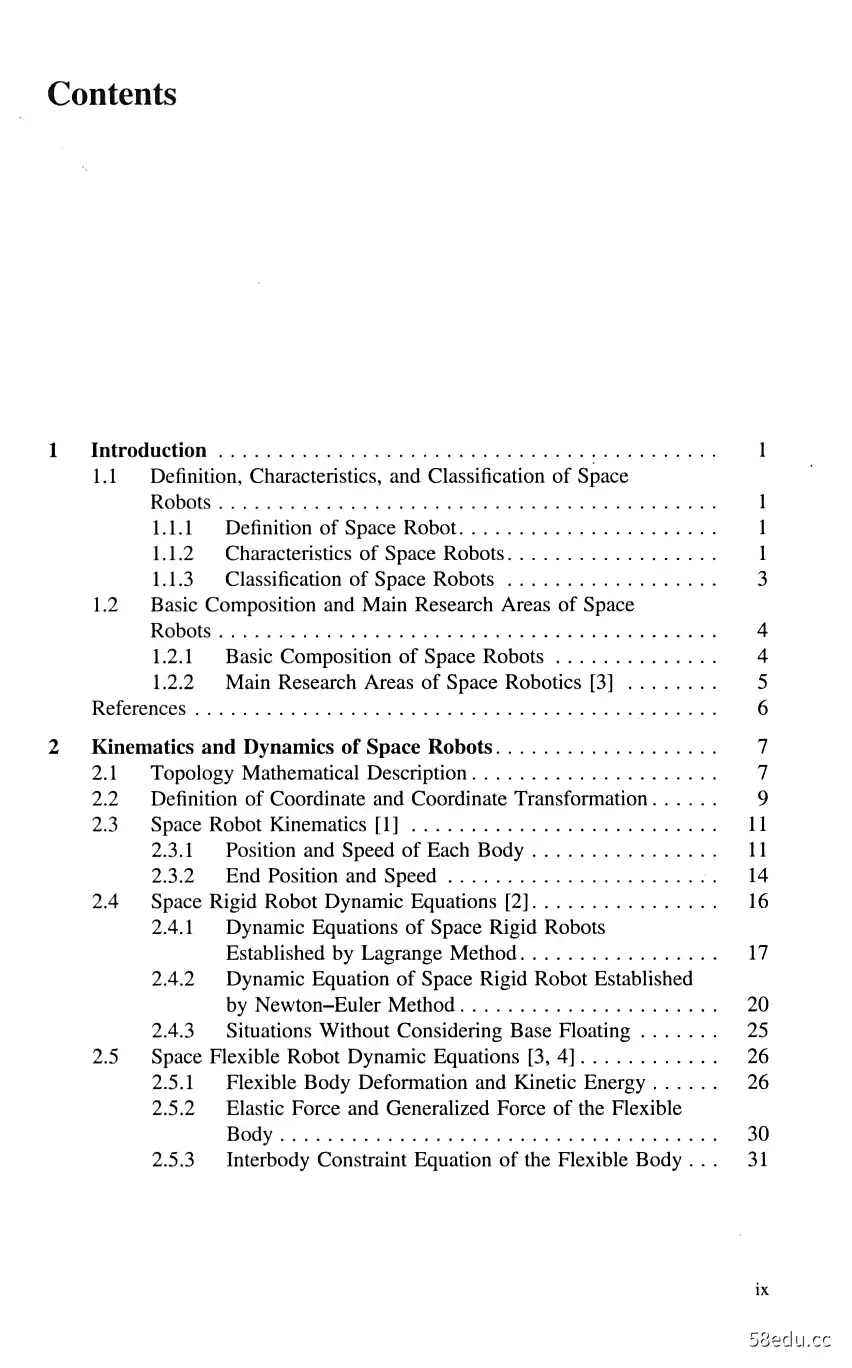《空间机器人 英文》王耀兵著|(epub+azw3+mobi+pdf)电子书下载
图书名称:《空间机器人 英文》
- 【作 者】王耀兵著
- 【页 数】 363
- 【出版社】 北京:北京理工大学出版社 , 2020.11
- 【ISBN号】978-7-5682-9147-7
- 【价 格】132.00
- 【分 类】空间机器人-英文
- 【参考文献】 王耀兵著. 空间机器人 英文. 北京:北京理工大学出版社, 2020.11.
图书封面:
图书目录:


《空间机器人 英文》内容提要:
《空间机器人 英文》内容试读
Chapter 1
Introduction
1.1Definition,Characteristics,and Classification of Space
Robots
1.1.1 Definition of Space Robot
Nowadays,the term"Space Robotics"is very familiar to those working in the fieldof robotics [1],but there is still no universally accepted definition of a"space robot".
Lin Yiming et al.defined space robots in their work"The Current Status and Analysisof Space Robots"as"a class of special robots that perform tasks in space such as thesupport for the construction and operation of space stations,the satellite assemblyand service,and the planetary surface exploration and testing [2]".
In the Chinese Institute of Electronics(CIE)standard"General Technical Require-ments for Space Robotics"(T/CIE045-2017),a space robot is defined as"the robotthat is applied to the space beyond the Earth's atmosphere (including the space insideand outside spacecraft,and celestial bodies)".By combining the above definitions,we think that the main difference between space robots and other robots stems fromthe particularity of their operating environment.Therefore,in this book,the spacerobot will be defined as a kind of special robot used in space beyond the Earth'satmosphere.
1.1.2 Characteristics of Space Robots
Space robots are special robots used in space.Due to the particularity of their appli-cation environment,space robots have the following characteristics compared toterrestrial robots:
(1)Special working environment.Space robots work in extraterrestrial space.For
the space robots usually working on orbit,such conditions as ultra-vacuum,high
Beijing Institute of Technology Press and Springer Nature Singapore Pte Ltd.2021
Y.Wang,Space Robotics,Space Science and Technologies
2
1 Introduction
and low temperatures,strong radiation,microgravity,and complex illuminationneed to be considered.For the space robots that perform planetary explorationtasks,special topography,temperature,special atmosphere,gravel,dust,gravity,and other factors should be considered additionally.In addition,all static force,vibration,noise,shock,and other loads within the mission profile also need tobe considered for space robots.
(2)Multi-facet design constraints.In addition to meeting the requirements of ground
launch and space working environment,space robots should be designed underthe consideration of the resource constraints on configuration,mass,powerconsumption,installation space,communication,and field of view,as well asthe constraints on related interfaces,functions,and performance.
(3)High-reliability requirements.Space robots need to work in space for a long
time,basically without any maintenance during work.This requires them tohave high reliability under the onboard limited resources.
(4)Diversified tasks.Space robots usually undertake a variety of tasks,such as
the identification,measurement,capture,handling,installation,assembly,andreplacement of space targets,and sample collection and processing.The manip-ulated objects include flight products,cabins,modules,equipment,instruments,special tools,and space debris.Therefore,in the design of space robots,it isnecessary to take into account the special requirements of different missionsand different objects.
(5)Complex system composition.A space robot is a complex space system
involving multiple disciplines,such as materials,mechanics,machinery,elec-tronics,thermal control,optics,and control theory.In terms of composition,a space robot includes not only a mechanical system consisting of multiplejoints and end effectors,but also a perceptual system consisting of camerasand sensors,a control system consisting of an arm controller and several jointcontrollers,and a human-robot interaction system composed of an instructiongenerating module and a telemetry feedback module.
(6Difficult ground verification.A space robot is a kind of special robot designed
for the space environment.It is difficult to carry out physical test verificationof all operating conditions of space robots directly under ground gravity condi-tions.And the coupling effect of vacuum,microgravity or low gravity,high andlow temperatures,and other environmental conditions during on-orbit opera-tion is difficult to simulate on the ground,which brings great problems to thecomprehensiveness and sufficiency of space-robotics ground verification.
Based on the above characteristics of space robots,special attention should bepaid to the following problems their design and verification:
(1)Multidisciplinary design and optimization of space robot systems;
(2)Design of space environment adaptability,including the design and selection of
raw materials and components,the design of anti-cold welding and lubricationof moving parts,the thermal matching design of parts,and the design of theadaptability of parts and systems to force,heat,magnetism,and irradiation;
(3)Reliability and safety design for long-term services in harsh environments;
1.1 Definition,Characteristics,and Classification of Space Robots
3
(4)Space robot teleoperation under large delay conditions and its autonomous
planning and control algorithm design;
(5)Modification and verification of simulation models;
(6)Adequacy and coverage of ground test verification.
1.1.3 Classification of Space Robots
According to different principles,space robots can be classified in many ways.
According to the characteristics of missions and environmental factors,space robotscan be divided into on-orbit operation robots and planetary surface exploration robots.
The former includes those robots performing on-orbit monitoring,assembly,main-tenance,and upgrade tasks for the spacecraft,and assisting astronauts in completingon-orbit operations.The latter includes those robots performing planetary surfaceexploration,sample collection and scientific experiment tasks,and assisting astro-nauts in completing planetary exploration missions.All space robots that have beenverified by flight can be included in these two types.With reference to this classi-fication,this book divides space robots into on-orbit operation robots and planetaryexploration robots.
1.1.3.1 On-Orbit Operation Robots
The on-orbit operation robots mainly refer to the space robots that perform variousoperation tasks in the microgravity orbit environment.They include,but are notlimited to,free-flying robots,intra-and extra-vehicular operating robots in mannedspace station/space laboratory,and operating robots in unmanned space servicestations.These robots are used to provide a variety of on-orbit operation services,such as target capture,target transfer and release,on-orbit assembly,on-orbitservices (fuel refueling,module replacement,etc.),on-orbit manufacturing,andassisting astronauts in extra-vehicular activities (EVAs).The characteristics of theirworking environment include vacuum,strong radiation,microgravity,and alternatingtemperature.
1.1.3.2 Planetary Exploration Robots
Planetary exploration robots mainly refer to the space robots that perform tasks onthe moon,planets,and asteroids and other celestial bodies.They include,but arenot limited to,unmanned/manned exploration robots,planetary surface constructionrobots.These robots usually have a wheeled or legged mobile system,and are typi-cally equipped with manipulators.The tasks they perform mainly involve movingand operating,including planetary surface roaming,exploration in extreme areas,sample collection,scientific experiments,and base construction on planet surfaces,
1 Introduction
as well as joint exploration with astronauts.The characteristics of their working envi-ronment mainly include vacuum or special atmosphere,strong radiation,sand dust,special geological conditions,gravity,and special temperature environment.
1.2Basic Composition and Main Research Areas of Space
Robots
1.2.1 Basic Composition of Space Robots
Considering the complete loop of space robot mission,the ground control system isusually included in the space robot system.In this case,space robot systems can bedivided into the space portion and the ground portion in general.The space portionrefers to the part that performs tasks on orbit or on the celestial bodies.It is the mainpart of the space robot,which covers the main functional units of the space robot(such as perceptual unit,control unit,and execution unit)and the space teleoperationunit (such as the intra-vehicular teleoperation system).The ground portion refersto the functional units deployed on the ground to perform the space-oriented taskssuch as operational command input,feedback information reception,and operationalstatus monitoring.It is also called the ground teleoperation system of space robots.
According to its function,a space robot system can be divided into different units.
The typical division is as follows:
(1)Mechanical system:It is a system that supports a space robot to perform a
specified action,consisting of the mechanical components designed in specificforms according to the requirements of the mission.It usually includes hold-down and release mechanisms,joints that provide motion function for the robot,and end effectors that perform specific operations,as well as the wheels andtheir steering and drive units that support the movement of the space robot.
(2)Perceptual system:It is a system that supports a space robot to sense the
working environment,the operational object,and its own state.It is composedof various types of sensors,typically including imaging devices that acquirevisual information,force/tactile sensors that acquire force/tactile information,and information processing units.
(3)Control system:It is a system that supports the space robot to complete anal-
ysis,decision-making,planning,and motion control.It is usually composed ofcontrollers(consisting of a processing chip and peripheral circuits),processingmodules (exchanger),etc.
(4)Power system:It is a system that supports the space robot to obtain external
power sources and perform power distribution according to the power require-ments of each component.It usually includes power supply modules,powerdistribution modules,and wire harnesses.
(5)Thermal control system:It is a system that supports the space robot to maintain
the temperature of each component and device within the allowable temperature
1.2 Basic Composition and Main Research Areas of Space Robots
5
range.It typically includes a passive thermal control subsystem composed ofmultilayer insulation and thermal control coatings and an active thermal controlsubsystem consisting of temperature sensors,heaters,etc.
(6)
Human-robot interaction system:It is a system that supports operators toperform various mode controls on space robots.It usually includes a human-robot interaction interface device and a space robot state feedback displaymodule.The commonly used human-robot interaction mode is a teleopera-tion mode.The human-robot interaction system in this mode is usually called ateleoperation system,which typically includes a feedback module,a calculationmodule,an input module,and a simulation module.
(7)Communication system:It is a system that supports space robots to interact with
ground teleoperation systems or spacecraft systems and other space robots.Itincludes the communication links required for information interaction betweenspace and ground.
In the mission profile of a space robot,if there is a period of time when thespace robot operates as an independent spacecraft,for example,as a free-flyingrobot or a planetary surface rover to perform independent missions,the space robotgenerally has all of the above 7 systems.If the space robot only performs space tasksas a payload of the spacecraft,then in actual product design,it is not necessarilydesigned with all the systems described above.For example,a space robot systemassigned to a space station usually communicates with other spacecraft by means of acommunication system of the space station,so it does not have its own communicationsystem.The space robot system with high autonomy can independently performspace operation tasks without using a teleoperation system,so it doesn't need ateleoperation system.In addition,for space robot systems that may perform relativelysimple tasks or functions,some systems can be merged.For example,the thermalcontrol system is incorporated into the mechanical system,and the power systeminto the control system.
This book highlights the main systems of space robots,i.e.,mechanical system,perceptual system,control system,and human-robot interaction system(mainly usedfor teleoperation).
1.2.2 Main Research Areas of Space Robotics [3]
The main research areas of space robotics are related to the composition and appli-cation of space robots.The theories,methods,and engineering implementation tech-nologies involved are all those that the technicians should learn and study,specificallyincluding
(1)Space robot kinematics and dynamics;
(2)Space robot task planning and motion planning,including task decomposition,
path planning,and trajectory planning;
(3)
Space robot control,including robot motion control and force control;
6
1 Introduction
(4)Space robot system design;
(5)Space robot key subsystems design,such as the design of mechanical,control,
perceptual,and interaction subsystems;(6Space robot software;
(7)Space environment adaptability of space robots;
(8)Simulation and test verification of space robots;
(9)Human-robot collaboration and multi-robot collaboration;(10)Space robot autonomy and intelligence.
References
1.B.Siciliano,O.Khatib,Handbook of Robotics(Springer,New York,2007)
2.Y.Lin,D.Li,Y.Wang et al.,Current status and analysis of space robot.Spacecraft Eng.24(5).1-7(2015)
3.Y.Xiong,Robotics(Mechanical Industry Press,Beijing,1993)
···试读结束···


